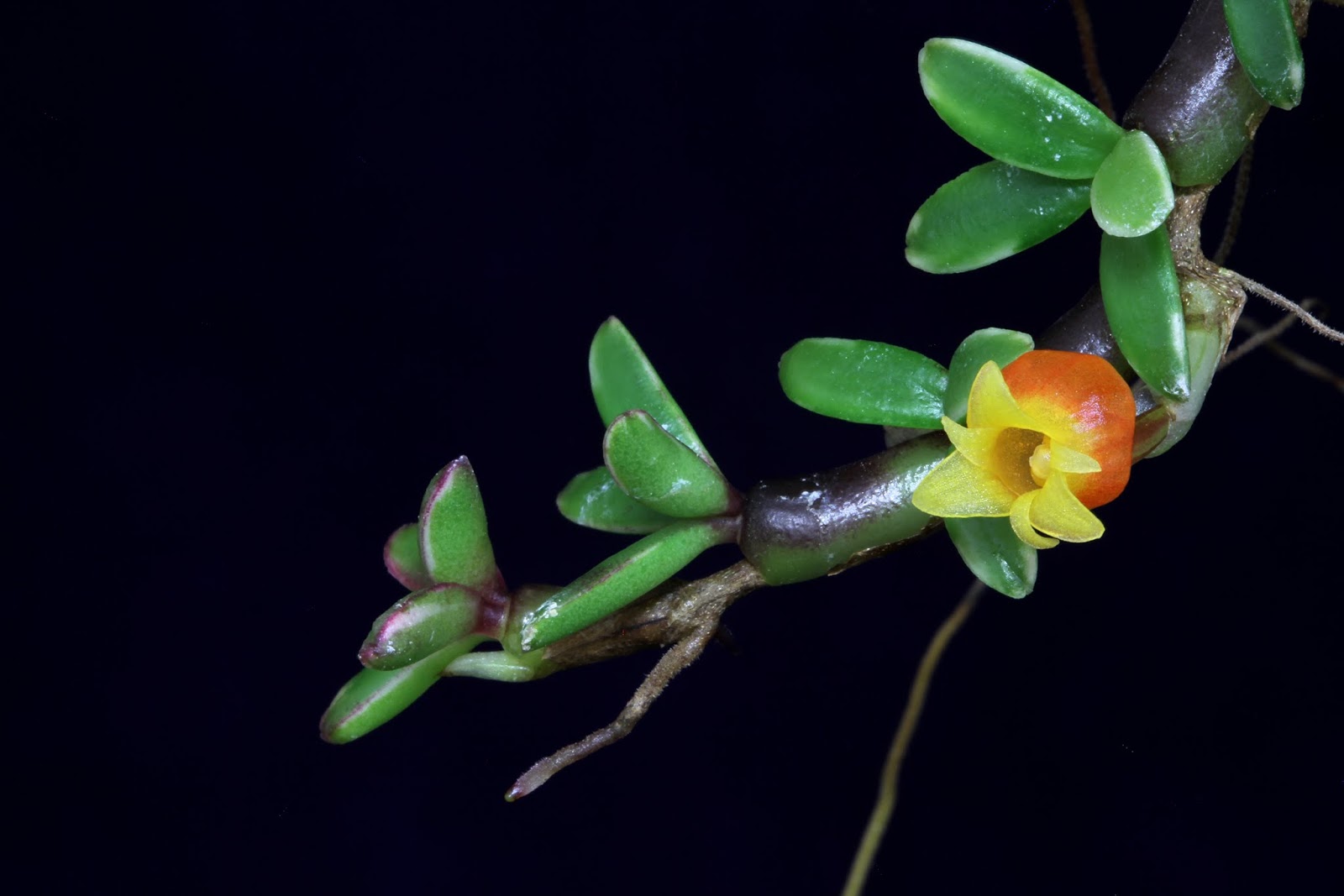Monday, May 26, 2014
Mediocalcar decoratum var. variegatum
Mediocalcar decoratum is a tiny plant that rambles, each new growth coming at the top of the last growth. The growths are interesting, too in that the leaves are arranged like a propeller at the top of a tiny cylindrical pseudobulb. The pseudobulbs with their leaves are only 2 cm and the flowers are even smaller, but brightly and unusually colored like little candy corns. The species from New Guinea, prefers cool temperatures, but is an easy orchid to grow. This plant has variegated foliage which adds a nice touch. It is still small and bloomed with only a couple flowers this spring, so I have only this one picture.
Labels:
mediocalcar,
mediocalcar decoratum,
new guinea,
orchid,
var. variegatum
Tuesday, May 20, 2014
Trisetella hirtzii
Like all the Trisetellas, this is a very small plant, only 3 cm tall, and the flowers, too, are typical of the genus both in color and with their odd little tails. The flowers are 1 cm and the plants blooms prolifically during the winter. It is from Ecuador and named after a well-known orchidist. It is related to Masdevallia, and like them prefers cool temperatures and good humidity.
'
'
Labels:
ecuador,
orchid,
pleurothallid,
trisetella,
trisetella hirtzii
Thursday, May 15, 2014
Mediocalcar versteegii 'Mountainside'
Medicolcar versteegii is from the highlands of New Guinea and has the brightly colored flowers and unusual color combinations that are common in the genus. The individual growths, a narrow cylindrical pseudobulb and a narrow lance-shaped leaf, are 9 cm tall and the flowers are only 1 cm, one flower per growth. The plants tends to ramble all over and I've had to tie it together with some mono-filament line. It is a little bit big and sprawling for my limited space, but I'd have trouble making the decision to get ride of it. It is charming.
Labels:
mediocalcar,
mediocalcar versteegii,
new guinea,
orchid
Saturday, May 10, 2014
Masdevallia mystica
Masdevallia mystica belongs to the Saltatrices group of Masdevallias. The species in this group have bright colors, tubular flowers and "bellies," a noticeable bulge at the base of the flower. This "species" is from Ecuador, but is probably a natural hybrid of Masdevallia filaria and Masdevallia ventricularia, two other species in this group. The plant is 10 cm tall and the flowers are surprisingly small, only a little over 2 cm What the plant lacks in flower size, however, it makes up in floriferousness, and can be completely covered with flowers when well grown.
Labels:
ecuador,
masdevallia,
masdevallia mystica,
orchid,
pleurothallid,
saltatrices
Thursday, May 8, 2014
Masdevallia hirtzii
This wonderful species is from Ecuador and Peru and belong to the Saltatrices group of Masdevallias. It is typical of the species in that group with brightly colored, tubular flowers that are lined with glandular hairs, and a pronounced swelling at the base of the flower, a "belly." The plant is 6-8 cm tall with 5 cm flowers and blooms for three or four months, though the individual flowers do not last that long.
Labels:
ecuador,
masdevallia,
masdevallia hirtzii,
orchid,
peru,
pleurothallid,
saltatrices
Friday, May 2, 2014
Dendrobium limpidum 'Ashley'
Dendrobium limpidum is from New Guinea and belongs to the Pedilonum section of the very large Dendrobium genus. This group of Dendrobiums have arching or pendant canes and most of them are quite large. This plant is one of the smallest in the group.
It is considered by some to be the same plant as Dendrobium dichaeoides. Whether the same or not I am unable to judge, but the plants do resemble another orchid genus named Dichaea with their closely set alternating leaves, and are quite beautiful in their own right.
The canes are about 10 cm in length and produce clusters of rather small flowers that impress more by their bright color and number than by their individual beauty. The flowers are less than 2 cm but come in clusters of around 15 flowers.
Like the plants in the Pedilonum section the flowers tend to be more or less tubular. In this case the flowers are not only tubular but do not open very far and have a lip that curls up to block most of the open end of the flowers. This can be seen in the close-up photos.
One very nice thing about this species is that the older canes continue to produce flowers for several years, though the new canes do not bloom the first year. The older canes eventually lose their leaves but will even then continue to produce flowers.
My plant is grown mounted and given as much light as I am able to give it. It is watered every day and seems to be quite easy as long as the temperatures are not too high and the humidity not too low. That it's happy is evidenced by the number of flowers this year.
Labels:
Dendrobium,
dendrobium limpidum,
new guinea,
orchid,
pedilonum
Subscribe to:
Comments (Atom)























